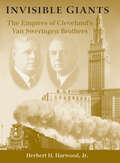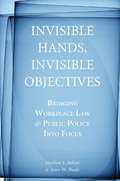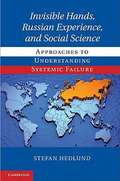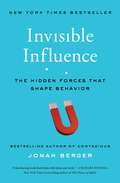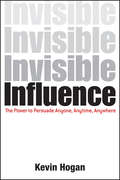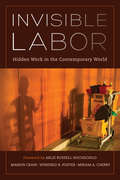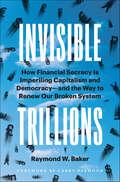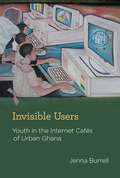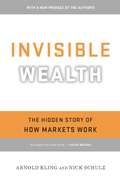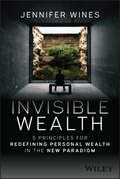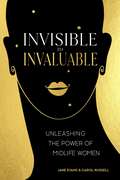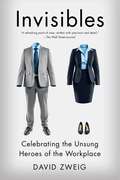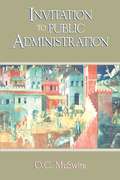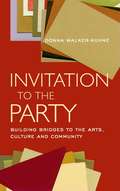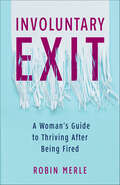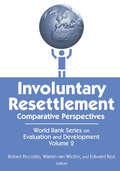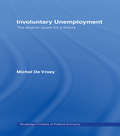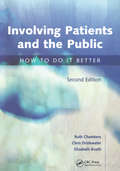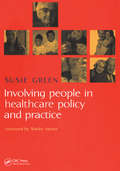- Table View
- List View
Invisible Giants: The Empires of Cleveland's Van Sweringen Brothers
by Herbert H. Harwood Jr.A comprehensive biography of the rise of the famous railroad barons who developed Shaker Heights, Ohio.Invisible Giants is the Horatio Alger-esque tale of a pair of reclusive Cleveland brothers, Oris Paxton and Mantis James Van Sweringen, who rose from poverty to become two of the most powerful men in America. They controlled the country’s largest railroad system—a network of track reaching from the Atlantic to Salt Lake City and from Ontario to the Gulf of Mexico. On the eve of the Great Depression they were close to controlling the country’s first coast-to-coast rail system—a goal that still eludes us. They created the model upper-class suburb of Shaker Heights, Ohio, with its unique rapid transit access. They built Cleveland’s landmark Terminal Tower and its innovative “city within a city” complex. Indisputably, they created modern Cleveland.Yet beyond a small, closely knit circle, the bachelor Van Sweringen brothers were enigmas. Their actions were aggressive, creative, and bold, but their manner was modest, mild, and retiring. Dismissed by many as mere shoestring financial manipulators, they created enduring works, which remain strong today. The Van Sweringen story begins in early-twentieth-century Cleveland suburban real estate and reaches its zenith in the heady late 1920s, amid the turmoil of national transportation power politics and unprecedented empire-building. As the Great Depression destroyed many of their fellow financiers, the “Vans” survived through imaginative stubbornness—until tragedy ended their careers almost simultaneously. Invisible Giants is the first comprehensive biography of these two remarkable if mysterious men.
Invisible Hands, Invisible Objectives: Bringing Workplace Law and Public Policy into Focus
by Stephen F. Befort John W. BuddWritten for policymakers and scholars, this volume shows how the current global financial crisis affects free market ideologies, and how employment relationships in the United Sates need to be reworked in terms of regulations and economic efficiency. Befort (law, U. of Minnesota Law School) and Budd (management, U. of Minnesota) introduce a set of reforms that address regulatory enforcement, employee benefits, living wages, workplace safety and health, balanced income distributions and labor unions. The authors also emphasize the need for explicitness in all aspects of workplace law and public policy. Annotation ©2009 Book News, Inc. , Portland, OR (booknews. com)
Invisible Hands, Russian Experience, and Social Science
by Stefan HedlundThis book investigates cases in which national and international activities have gone massively wrong, entailing seriously negative consequences, and in which the sophisticated analytical models of social science have ceased to be helpful. Illustrations range from the global financial crisis to the failure to achieve speedy systemic change in the former Soviet Union and the failure to achieve development in the Third World. The analysis uses as a backdrop long-term Russian history and short-term Russian encounters with unrestrained capitalism to develop a framework that is based in the so-called new institutionalism. Understanding the causes of systemic failure is shown to require an approach that spans across the increasingly specialized subdisciplines of modern social science. Demonstrating that increasing theoretical sophistication has been bought at the price of a loss of perspective and the need for sensitivity to the role of cultural and historical specificity, the book pleads the case for a new departure in seeking to model the motives for human action.
Invisible Influence: The Hidden Forces that Shape Behavior
by Jonah BergerThe New York Times bestselling author of Contagious explores the subtle, secret influences that affect the decisions we make--from what we buy, to the careers we choose, to what we eat--in this fascinating and groundbreaking work.If you're like most people, you think that your choices and behaviors are driven by your individual, personal tastes, and opinions. You wear a certain jacket because you liked the way it looked. You picked a particular career because you found it interesting. The notion that our choices are driven by our own personal thoughts and opinions is patently obvious. Right? Wrong. Without our realizing it, other people's behavior has a huge influence on everything we do at every moment of our lives, from the mundane to the momentous occasion. Even strangers have a startling impact on our judgments and decisions: our attitudes toward a welfare policy shift if we're told it is supported by Democrats versus Republicans (even though the policy is the same in both cases). But social influence doesn't just lead us to do the same things as others. In some cases we conform, or imitate others around us. But in other cases we diverge, or avoid particular choices or behaviors because other people are doing them. We stop listening to a band because they go mainstream. We skip buying the minivan because we don't want to look like a soccer mom. In his surprising and compelling Invisible Influence, Jonah Berger integrates research and thinking from business, psychology, and social science to focus on the subtle, invisible influences behind our choices as individuals. By understanding how social influence works, we can decide when to resist and when to embrace it--and how we can use this knowledge to make better-informed decisions and exercise more control over our own behavior.
Invisible Influence: The Power to Persuade Anyone, Anytime, Anywhere
by Kevin Hogan"Invisible Influence is a masterpiece in understanding the science of influence and how to take it from convincing to compelling. Kevin Hogan shows you in plain English how to understand, apply, and master the science of persuasion. The book is brilliant- and you can be brilliantly persuasive. Buy the book, read the book, and implement the book."-Jeffrey Gitomer, author of The Sales Bible and The Little Book of Leadership"One eyebrow-raising, head-whacking, forehead-slapping technique after another. Anyone whose daily life depends on influencing people-in other words, everyone-should read this book. Buy copies for your friends and hide it from your enemies."-Richard Brodie, author of Virus of the Mind: The New Science of the Meme"Master persuaders know that it's not really about the words you use or the moves you make-other people get persuaded because of what you think and how you feel. Kevin Hogan explains in delightfully clear detail how to make these master-persuader secrets work for you. Not only that, he also explains why all of this works, and he shows you the exact scientific research that proves it!"-David Garfinkel, author of Advertising Headlines That Make You Rich"Invisible Influence is a masterpiece. It will be the master influencer's reference book for the years to come. Invisible influence is like oxygen, you can't see it, but your life depends on it. In this book, you will discover the persuasion tactics that will compel your clients to say yes to you-again and again."-Roberto Monaco, www.influenceology.com"Dump the script-it's old news before the ink's dry. Trust yourself and use your new understanding of the ever-changing context to succeed. In his fascinating book, Hogan weaves established research findings into a handbook for successful influence. The guidelines are obvious but hidden, simple but profound. Understand them and you've mastered the complex and crucial art of persuasion."-William D. Crano, author of The Rules of Influence: Winning When You're in the Minority"Many write on the topic of persuasion. Precious few genuinely understand it. Kevin is one of those precious few. Read everything you can by him."-Mark Joyner, founder and CEO of Simpleology, www.simpleology.com
Invisible Labor: Hidden Work in the Contemporary World
by Marion Crain Miriam Cherry Winifred PosterAcross the world, workers labor without pay for the benefit of profitable businesses--and it's legal. Labor trends like outsourcing and technology hide some workers, and branding and employer mandates erase others. Invisible workers who remain under-protected by wage laws include retail workers who function as walking billboards and take payment in clothing discounts or prestige; waitstaff at "breastaurants" who conform their bodies to a business model; and inventory stockers at grocery stores who go hungry to complete their shifts. Invisible Labor gathers essays by prominent sociologists and legal scholars to illuminate how and why such labor has been hidden from view.
Invisible No More: Police Violence Against Black Women and Women of Color
by Angela Y. Davis Andrea RitchieA timely examination of the ways Black women, Indigenous women, and other women of color are uniquely affected by racial profiling, police brutality, and immigration enforcement.Invisible No More is a timely examination of how Black women, Indigenous women, and women of color experience racial profiling, police brutality, and immigration enforcement. Placing stories of individual women—such as Sandra Bland, Rekia Boyd, Dajerria Becton, Monica Jones, and Mya Hall—in the broader context of the twin epidemics of police violence and mass incarceration, it documents the evolution of movements centering women’s experiences of policing and demands a radical rethinking of our visions of safety—and the means we devote to achieving it.
Invisible Trillions: How Financial Secrecy Is Imperiling Capitalism and Democracy and the Way to Renew Our Broken System
by Raymond W. BakerEssential reading for anyone truly interested in saving democracy from the predations of kleptocracy and plutocracy. -Charles Davidson, The Journal of Democracy This book expands our understanding of the financial secrecy system dominating capitalism today and shows how we can create accountability to restore our democracy. Over the last half century, capitalism has created the means for trillions of dollars, euros, pounds, and other stores of wealth to move invisibly-beyond the control of central bankers, law enforcement agents, and international institutions. With an entire financial secrecy system now dominating capitalist operations, riches flow inexorably upward and accelerate economic inequality. And rising inequality is directly imperiling-weakening, obstructing, and degrading-democracy. This book is not a screed against capitalism-it is a call for capitalism to return to its roots, reenergizing its synergies with democracy. Raymond Baker writes, Democratic capitalism is, in my judgment, the best system yet devised in political economy, but dysfunctions within its capitalist component are undermining the two-part system. Baker explains the tax havens, secrecy jurisdictions, disguised corporations, anonymous trusts, fake foundations, regulatory loopholes, money laundering techniques, and more that make up the financial secrecy system. But he goes beyond the what to the why, examining the motivations driving the system that generates and shelters trillions of dollars that could go toward spreading wealth, generating public goods, and protecting the environment. Going deeper, Baker illustrates how these realities further corrode the commonwealth, with chapters devoted to the facilitating activities and impacts of banks, corporations, enabling lawyers and accountants, governments, and international institutions and concluding with the limiting role played in policy silos that are missing the bigger picture. Finally, he provides specific, pragmatic measures to reset capitalism so that it once again contributes to shared prosperity and sustained democracy. This is a magisterial treatment of an issue that is at the root of so many problems that plague our nation and the world today.
Invisible Users
by Jenna BurrellThe urban youth frequenting the Internet cafes of Accra, Ghana, who are decidedly not members of their country's elite, use the Internet largely as a way to orchestrate encounters across distance and amass foreign ties--activities once limited to the wealthy, university-educated classes. The Internet, accessed on second-hand computers (castoffs from the United States and Europe), has become for these youths a means of enacting a more cosmopolitan self. In Invisible Users, Jenna Burrell offers a richly observed account of how these Internet enthusiasts have adopted, and adapted to their own priorities, a technological system that was not designed with them in mind. Burrell describes the material space of the urban Internet cafe and the virtual space of push and pull between young Ghanaians and the foreigners they encounter online; the region's famous 419 scam strategies and the rumors of "big gains" that fuel them; the influential role of churches and theories about how the supernatural operates through the network; and development rhetoric about digital technologies and the future viability of African Internet cafes in the region. Burrell, integrating concepts from science and technology studies and African studies with empirical findings from her own field work in Ghana, captures the interpretive flexibility of technology by users in the margins but also highlights how their invisibility puts limits on their full inclusion into a global network society.
Invisible Wealth
by Arnold Kling Nick SchulzThe discipline of economics is not what it used to be. Over the last few decades, economists have begun a revolutionary reorientation in how we look at the world, and this has major implications for politics, policy, and our everyday lives. For years, conventional economists told us an incomplete story that leaned on the comfortable precision of mathematical abstraction and ignored the complexity of the real world with all of its uncertainties, unknowns, and ongoing evolution.What economists left out of the story were the positive forces of creativity, innovation, and advancing technology that propel economies forward. Economists did not describe the dynamic process that leads to new pharmaceuticals, cell phones, Web-based information services-forces that fundamentally alter how we live our daily lives.Economists also left out the negative forces that can hold economies back: bad governance, counterproductive social practices, and patterns of taking wealth instead of creating it. They took for granted secure property rights, honest public servants, and the willingness of individuals to experiment and adapt to novelty.From Poverty to Prosperity is not Tipping Point or Freakonomics. Those books offer a smorgasbord of fascinating findings in economics and sociology, but the findings are only loosely related. From Poverty to Prosperity on the other hand, tells a big picture story about the huge differences in the standard of living across time and across borders. It is a story that draws on research from the world's most important economists and eschews the conventional wisdom for a new, more inclusive, vision of the world and how it works.
Invisible Wealth: 5 Principles for Redefining Personal Wealth in the New Paradigm
by Jennifer WinesA new paradigm of value creation, driven by your personal values. In Invisible Wealth: 5 Principles for Redefining Personal Wealth in the New Paradigm, certified wealth management advisor and entrepreneur, Jennifer Wines, delivers an insightful exploration into reimagining and redefining wealth. This book explores the technological advancements and societal shifts that have us considering everything from digital assets to digital community, all of which are organized around values. This new paradigm places a premium on intangible, or invisible, assets represented by 5 principles—money, health, knowledge, time, and relationships—each of which is attainable through your own personal, renewable resources. This paradigm shift takes on a more holistic and personalized approach to defining wealth. In this book, you’ll discover: How to use the personal wealth algorithm to identify your values, and wealth goals. How to optimize your most valuable asset, your time. How technology can support your wealth and well-being. Offering pragmatic and philosophical considerations for redefining what’s truly important to you, Invisible Wealth belongs in the hands of anyone seeking a rich life. It’s time to reimagine and redefine what wealth means to you.
Invisible Wounds of War: Psychological and Cognitive Injuries, Their Consequences, and Services to Assist Recovery
by Terri Tanielian Lisa H. JaycoxSince October 2001, approximately 1.64 million U.S. troops have been deployed for Operations Enduring Freedom and Iraqi Freedom (OEF/OIF) in Afghanistan and Iraq. Early evidence suggests that the psychological toll of these deployments many involving prolonged exposure to combat-related stress over multiple rotations--may be disproportionately high compared with the physical injuries of combat. In the face of mounting public concern over post-deployment health care issues confronting OEF/OIF veterans, several task forces, independent review groups, and a Presidential Commission have been convened to examine the care of the war wounded and make recommendations. Concerns have been most recently centered on two combat-related injuries in particular: post-traumatic stress disorder and traumatic brain injury. With the increasing incidence of suicide and suicide attempts among returning veterans, concern about depression is also on the rise. The study discussed in this monograph focuses on post-traumatic stress disorder, major depression, and traumatic brain injury, not only because of current high-level policy interest but also because, unlike the physical wounds of war, these conditions are often invisible to the eye, remaining invisible to other servicemembers, family members, and society in general. All three conditions affect mood, thoughts, and behavior; yet these wounds often go unrecognized and unacknowledged. The effect of traumatic brain injury is still poorly understood, leaving a large gap in knowledge related to how extensive the problem is or how to address it. RAND conducted a comprehensive study of the post-deployment health-related needs associated with these three conditions among OEF/OIF veterans, the health care system in place to meet those needs, gaps in the care system, and the costs associated with these conditions and with providing quality health care to all those in need. This monograph presents the results of our study, which should be of interest to mental health treatment providers; health policymakers, particularly those charged with caring for our nation's veterans; and U.S. service men and women, their families, and the concerned public. All the research products from this study are available at http://veterans.rand.org. Data collection for this study began in April 2007 and concluded in January 2008. Specific activities included a critical review of the extant literature on the prevalence of post-traumatic stress disorder, major depression, and traumatic brain injury and their short- and long-term consequences; a population-based survey of servicemembers and veterans who served in Afghanistan or Iraq to assess health status and symptoms, as well as utilization of and barriers to care; a review of existing programs to treat servicemembers and veterans with the three conditions; focus groups with military servicemembers and their spouses; and the development of a microsimulation model to forecast the economic costs of these conditions over time. Among our recommendations is that effective treatments documented in the scientific literature, evidence-based care--are available for PTSD and major depression. Delivery of such care to all veterans with PTSD or major depression would pay for itself within two years, or even save money, by improving productivity and reducing medical and mortality costs. Such care may also be a cost-effective way to retain a ready and healthy military force for the future. However, to ensure that this care is delivered requires system-level changes across the Department of Defense, the Department of Veterans Affairs, and the U.S. health care system.
Invisible to Invaluable: Unleashing the Power of Midlife Women
by Jane Evans Carol RussellOur generation is something the world has never seen before. Women born between 1950 and 1975 were pioneers in all areas of work and society, yet we have become almost completely invisible except to our families and friends, right at the time the world needs our wisdom, empathy and experience the most.OUR TIME IS NOW!INVISIBLE TO INVALUABLE is a celebration of what midlife women do, who we are and what we are capable of. It's a rallying cry for us to change the world for the better.With personal stories, exciting research and insights from a cast of inspirational women, Jane Evans and Carol Russell's manifesto blows open the ageism that's sidelined midlife women at work and in society, and sets out an empowering vision for a world where we can unlock our full potential. In a collection of chapters that range from the powerful to the playful and from the distant past to a brighter future, Jane and Carol show how there is no longer just 'young' and 'old' - there is a whole new middle that can be the best time of our lives.Even if we feel like we've hit rock bottom, or have disappeared entirely, there is a way back. This book will remind you how far we've come, show you what we're made of, and demonstrate how we can create a better future for all of us.
Invisible to Invaluable: Unleashing the Power of Midlife Women
by Jane Evans Carol RussellOur generation is something the world has never seen before. Women born between 1950 and 1975 were pioneers in all areas of work and society, yet we have become almost completely invisible except to our families and friends, right at the time the world needs our wisdom, empathy and experience the most.OUR TIME IS NOW!INVISIBLE TO INVALUABLE is a celebration of what midlife women do, who we are and what we are capable of. It's a rallying cry for us to change the world for the better.With personal stories, exciting research and insights from a cast of inspirational women, Jane Evans and Carol Russell's manifesto blows open the ageism that's sidelined midlife women at work and in society, and sets out an empowering vision for a world where we can unlock our full potential. In a collection of chapters that range from the powerful to the playful and from the distant past to a brighter future, Jane and Carol show how there is no longer just 'young' and 'old' - there is a whole new middle that can be the best time of our lives.Even if we feel like we've hit rock bottom, or have disappeared entirely, there is a way back. This book will remind you how far we've come, show you what we're made of, and demonstrate how we can create a better future for all of us.
Invisible to Invaluable: Unleashing the Power of Midlife Women
by Jane Evans Carol RussellOur generation is something the world has never seen before. Women born between 1950 and 1975 were pioneers in all areas of work and society, yet we have become almost completely invisible except to our families and friends, right at the time the world needs our wisdom, empathy and experience the most.OUR TIME IS NOW!INVISIBLE TO INVALUABLE is a celebration of what midlife women do, who we are and what we are capable of. It's a rallying cry for us to change the world for the better.With personal stories, exciting research and insights from a cast of inspirational women, Jane Evans and Carol Russell's manifesto blows open the ageism that's sidelined midlife women at work and in society, and sets out an empowering vision for a world where we can unlock our full potential. In a collection of chapters that range from the powerful to the playful and from the distant past to a brighter future, Jane and Carol show how there is no longer just 'young' and 'old' - there is a whole new middle that can be the best time of our lives.Even if we feel like we've hit rock bottom, or have disappeared entirely, there is a way back. This book will remind you how far we've come, show you what we're made of, and demonstrate how we can create a better future for all of us.
Invisibles
by David ZweigWhat do fact-checkers, anesthesiologists, U.N. interpreters, and structural engineers have in common? When they do their jobs poorly, the consequences can be catastrophic for their organizations. But when they do their jobs perfectly . . . they're invisible. For most of us, the better we perform the more attention we receive. Yet for many "Invisibles"--skilled professionals whose role is critical to whatever enterprise they're a part of--it's the opposite: the better they do their jobs the more they disappear. In fact, often it's only when something goes wrong that they are noticed at all. Millions of these Invisibles are hidden in every industry. You may be one yourself. And despite our culture's increasing celebration of fame in our era of superstar CEOs and assorted varieties of "genius"--they're fine with remaining anonymous. David Zweig takes us into the behind-the-scenes worlds that Invisibles inhabit. He interviews top experts in unusual fields to reveal the quiet workers behind public successes. Combining in-depth profiles with insights from psychology, sociology, and business, Zweig uncovers how these hidden professionals reap deep fulfillment by relishing the challenges their work presents. Zweig bypasses diplomats and joins an elite interpreter in a closed-door meeting at the U.N., where the media and public are never allowed. He ascends China's tallest skyscraper while it's still under construction, without the architect, guided instead by the project's lead structural engineer. He even brings us on stage during a Radiohead concert, escorted not by a member of the band, but by their chief guitar technician. Along the way, Zweig reveals that Invisibles have a lot to teach the rest of society about satisfaction and achievement. What has been lost amid the noise of self-promotion today is that not everyone can, or should, or even wants to be in the spotlight. This inspiring and illuminating book shows that recognition isn't all it's cracked up to be, and invisibility can be viewed as a mark of honor and a source of a truly rich life.
Invisibles
by David ZweigAn inspiring look at the hidden stars in every field who perform essential work without recognition In a culture where so many strive for praise and glory, what kind of person finds the greatest reward in anonymous work? Expanding from his acclaimed Atlantic article, "What Do Fact-Checkers and Anesthesiologists Have in Common?" David Zweig explores what we can all learn from a modest group he calls "Invisibles." Their careers require expertise, skill, and dedication, yet they receive little or no public credit. And that's just fine with them. Zweig met with a wide range of Invisibles to discover first hand what motivates them and how they define success and satisfaction. His fascinating subjects include: * a virtuoso cinematographer for major films. * the lead engineer on some of the world's tallest skyscrapers. * a high-end perfume maker. * an elite interpreter at the United Nations. Despite the diversity of their careers, Zweig found that all Invisibles embody the same core traits. And he shows why the rest of us might be more fulfilled if we followed their example.From the Hardcover edition.r and a source of a truly rich life.
Invitation to Public Administration
by O. C. McSwiteThis engaging book presents a model for personal reflection on what a career in public service means. It's designed not to convince the reader to take up a public service career, but rather to invite him or her to explore the implications for one's identity that are inherent in the public service life. Lively and anecdotal, Invitation to Public Administration directly confronts the various difficult issues involved with a public service career even as it evokes self-reflection. It is equally useful for undergraduate through Ph.D. level readers, and it is ideal supplemental reading for any foundational course in Public Administration. The book will also stimulate public service professionals seeking fresh insights for their own careers.
Invitation to the Party
by Donna Walker-Kuhne George C. WolfeAcknowledged as the nation's foremost expert on audience development involving America's growing multicultural population by the Arts and Business Council, Donna Walker-Kuhne has now written the first book describing her strategies and methods to engage diverse communities as participants for arts and culture. By offering strategic collaborations and efforts to develop and sustain nontraditional audiences, this book will directly impact the stability and future of America's cultural and artistic landscape. Donna Walker-Kuhne has spent the last 20 years developing and refining these principles with such success as both the Broadway and national touring productions of Bring in 'Da Noise, Bring in 'Da Funk, as well as transforming the audiences at one of the U.S.'s most important and visible arts institutions, New York's Public Theater. This book is a practical and inspirational guide on ways to invite, engage and partner with culturally diverse communities, and how to enfranchise those communities into the fabric of arts and culture in the United States.Donna Walker-Kuhne is the president of Walker International Communications Group. From 1993 to 2002, she served as the marketing director for the Public Theater in New York, where she originated a range of audience-development activities for children, students and adults throughout New York City. Ms. Walker-Kuhne is an Adjunct Professor in marketing the arts at Fordham University, Brooklyn College and New York University. She was formerly marketing director for Dance Theatre of Harlem. Ms. Walker-Kuhne has given numerous workshops and presentations for arts groups throughout the U.S., including the Arts and Business Council, League of American Theaters and Producers, the Department of Cultural Affairs, and the National Endowment for Arts to name a few. She has been nominated for the Ford Foundation's 2001 Leadership for a Changing World Fellowship.
Invitations to Tender for Facility Management Services: A Practical Guide For Effective Writing And Critical Analysis (Springer Tracts in Civil Engineering)
by Cinzia Talamo Nazly AttaThis book deals with Invitations to Tender (ITTs) for the provision of Facility Management (FM) services. It presents a framework to support companies in preparing clear, comprehensive and effective ITTs, focusing on such key aspects as: organizational structures, tools and procedures for managing information, allocation of information responsibilities, procedures for services monitoring and control, quality policies, and risk management. It discusses and analyzes a range of basic terms and concepts, procedures, and international standards concerning the Tendering Process, as well as the contents of ITTs, which should represent the translation of information needs into requirements related to: the client’s goals, main categories of information to deal with, expected organization of information, modalities of reporting and control, and level of knowledge to be reached. A further major focus is on potential key innovation scenarios concerning current FM practice, such as Sustainable Procurement, Building Information Modeling (BIM), Big Data and Internet of Things (IoT) technologies, highlighting both the possible benefits and the possible risks and implications that could negatively affect the quality of FM service provision if not properly treated within the ITT. The book will be of interest to real estate owners, demand organizations and facility managers, enhancing their ability to prepare, interpret and/or critically analyze ITTs.
Involuntary Exit: A Woman's Guide to Thriving After Being Fired
by Robin MerleIt can take less than a minute to get fired. Less than a minute to hear the words that change your life as you’ve known it. You’re stunned, shocked, humiliated—because your career has defined your life and you’ve been blindsided. You’re a company Loyalist with a capital L, and you’ve been sucker punched professionally. How do you even talk about this?Countless books focus on leadership and resilience, but none of them take you through what actually happens to women leaders who are suddenly let go, or who endure untenable circumstances and ultimately fire themselves. None of them take you, step by step, through the emotional process of acceptance and beginning again. And that’s where Involuntary Exit comes in.With advice for every unexpected twist, turn, and emotional trigger, this book is based on author Robin Merle’s experience at the top of billion-dollar organizations, as well as her interviews with accomplished women who were suddenly severed from their organizations and navigated their way back to success. The real-life examples she offers in these pages prove that you’re not alone—and that you, too, will get through this. Whether you’ve been fired or need to move on, Involuntary Exit will help you rediscover your value and emerge as a stronger leader on your own terms.
Involuntary Resettlement: Comparative Perspectives (World Bank Series On Evaluation And Development Ser. #Vol. 2)
by Warren van WicklinAmong development assistance agencies, the World Bank has led the way in policies to mitigate the impact of large-scale engineering projects on local populations, particularly in the building of dams. Since the 1980s the Bank has implemented guidelines for policies with respect to displacement, social infrastructure and services, environmental effects, resettlement, compensation, and the restoration of income for those affected. Having learned from the failures of past resettlement programs, the Bank has endeavored to function as a responsible and caring agency. This volume builds upon earlier studies and field work to offer a broad look at dam-building projects in six countries and to review the outcomes of Bank policy, learn from experience, and assess outside criticism. The book covers representative dam projects in India, Thailand, Togo, China, Indonesia, and Brazil. Each project was undertaken after Bank resettlement guidelines had been implemented. The widely ranging results in each country are assessed. In the areas of compensation for acquired land, relocation, infrastructure and services, the contributors note satisfactory levels of improvement or positive trends. Governments are moving towards acceptance of the idea that displaced families should be paid the real value of their lost assets. Relocation processes are now keeping pace with water movement caused by dam building, and health, education, utilities, and roads are better than before the resettlement. Other results have been less positive. The impact on incomes of those involuntarily resettled has been harsh in some locations. Resettler dissatisfaction has been intense, notably in those countries where the national economies are not experiencing strong growth. The Bank's performance itself has been uneven. There have been lapses in appraisal and monitoring during the projects and insufficient follow-through support for resettlement operations after the completion of loan and credit disbursements. In addition to its case by case analysis of countries and projects, the book includes detailed lessons and recommendations to strengthen resettlement policy and practice. Involuntary Resettlement will be of interest to economists, sociologists, and professionals working in regional development policy. Robert Picciotto is director general of Operations Evaluation at the World Bank. Warren van Wicklin is task manager and evaluator at the Operations Evaluation department of the World Bank.
Involuntary Unemployment: The Elusive Quest For A Theory (Routledge Frontiers Of Political Economy Ser. #Vol. 33)
by Michel de VroeyThe Great Depression of the 1930s with its dramatic unemployment rates was one of the most striking economic events of the past century. It shook economists' beliefs in the existence of self-adjusting forces and prompted Keynes to write his masterwork, The General Theory of Employment, Interest and Money. Involuntary unemployment was the central co
Involving Patients and the Public: How to do it Better
by Ruth Chambers Elizabeth Boath Chris DrinkwaterPatient and public involvement in health and social care has become a key element of government policy, and the need to listen and act on the views of patients and the public is an increasingly integral part of the planning and delivery of healthcare. This new edition has been completely revised and updated, providing practical information on the new responsibilities under clinical governance and Health Improvement Programmes, including useful website links and contact details. It offers clear and straightforward practical advice and provides an introduction to the new structures and processes being set up to enable patients and the public to be more influential in designing and delivering healthcare services. This book is essential reading for all healthcare professionals including doctors, nurses and therapists, and those with management responsibilities, as well as policy shapers and patient organisations.
Involving People in Healthcare Policy and Practice
by Susie GreenThis book explores the link between the ‘corridors of power’ where healthcare policy is made and the hospital, health center or clinic where it is carried out. It encourages and empowers readers to make changes in the public’s involvement at a local level and explains how this impacts positively on organizational culture. A user-friendly book written in a light and easy-to-read style, it combines theoretical arguments with tried and tested practical applications and features contributions from a wide range of experienced professionals. This is essential reading for every member of the healthcare team. It will be of particular interest to patient and public involvement leads as well as patient advice and liaison service workers, healthcare policy makers and shapers, students and patient groups.
